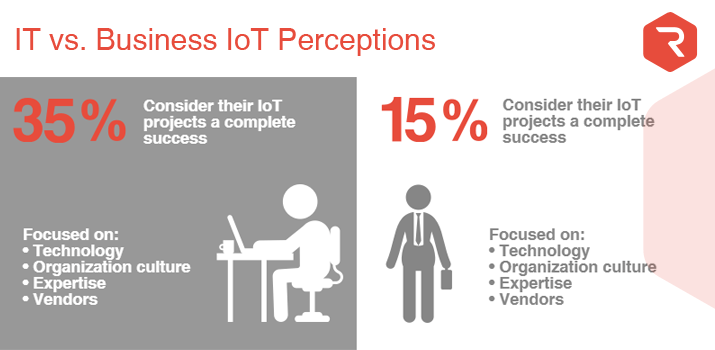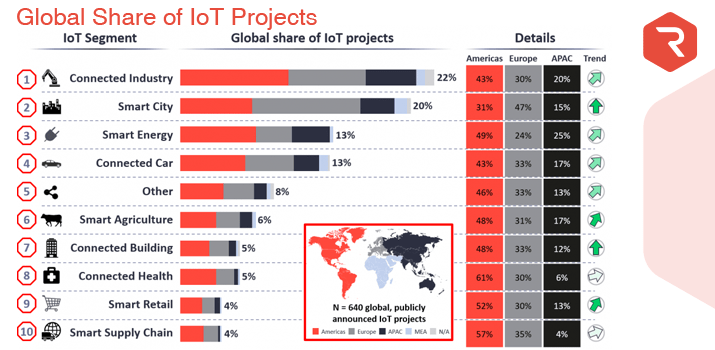Gartner claims the global IoT installed base will reach 8.4 billion units by the end of this year. The Internet of Things’ revenue opportunity will top $ 4.5 trillion in 2018. Soon IoT will be bigger than the Internet itself. However, 75% of IoT hardware and software development projects fail to meet business objectives. Here’s why.
Top 3 factors behind IoT project development failures
According to Cisco’s recent survey, 60% of IoT projects come to a standstill during the Proof of Concept stage. What’s more, only 26% of completed IoT projects are considered successful by their vendors.
Chuck Robbins, CEO at Cisco, believes it is the lack of interest from business executives who don’t buy into the new tech (as they don’t see the immediate benefits of using IoT solutions) that undermine the Internet of Things’ success. IoT insecurity might be an issue, too– after all, 90% of connected gadgets are subject to remote attacks. And there goes smart gadgets’ interoperability (or lack thereof): each vendor including Apple and Amazon wants to create an IoT of their own, thus depriving customers of an opportunity to manage Wemo Switch, Nest thermostat and Amazon Echo via a universal hub.

R-Style Lab has worked on several Internet of Things software development projects so far. We’ve built a prototype of a Home Automation system that implements the facial recognition technology and gets smarter over time, a sleek iOS app for a custom EKG tracker, mobile applications for connected exercise equipment, etc.
Based on our experience, we shall single out three major factors that keep IoT vendors away from success:
- Technology limitations. Every IoT project starts with a Proof of Concept – the confirmation that a certain device/software system can perform its intended functions and be a commercial success. During the PoC stage, an IoT vendor creates hardware prototypes using off-the-shelf solutions like Raspberry PI or Arduino and writes small parts of mobile and web apps to make sure sensors capture data accurately (while the data is sent to the cloud or on-prem servers) – and here’s where barriers to success typically emerge. Our company, for instance, has once worked on a machine vision system that was supposed to decode the X-ray images of prosthetic intervertebral disks. The app’s accuracy did not exceed 70% – simply because modern X-ray machines fail to produce 4K images. In the end, the project was postponed. It’s the same with IoT. Everyone needs a smartwatch that would track users’ physical activity, display calls and messages delivered onto a smartphone, run multiple apps and act as a personal emergency response system – and nobody wants to recharge the gadget three times a day. Limited RAM, high energy consumption, data processing issues and API conflict might prevent prototypes from working; however, the success of an IoT endeavour largely depends on software developers’ expertise (and familiarity with Internet of Things development). The EKG data visualization app we’ve mentioned above, for example, was meant to render sensor data in real time using the Core Plot library. However, the library had to re-draw graphs with each update; the lag between data processing and rendering was estimated at 2-3 seconds. In order to render sensor data in real time, we turned to low-level programming and implemented the OpenGL library (which is familiar to only 20% of software developers out there and most often used in game development) instead. If our customer had addressed another vendor, his app might’ve made it to the unlucky 60% of projects that never materialize;
- Lack of collaboration between IT and business development departments. 54% of companies that participated in IoT World Forum last month cited collaboration between the IT and business sides as the key factor behind a successful IoT project. While 35% of IT decision-makers consider their IoT initiatives a complete success (having emphasized the importance of the new tech as such), only 15% of business leaders are entirely satisfied with their past and ongoing IoT projects (simply because they put milestones – including ROI – first). If you want to make IoT part of your enterprise software system or consider launching a consumer-oriented product, you should study the initial demand for the solution, create use cases for your product and develop a monetization strategy long before the dev process begins. The lack of a market need for a product is, in fact, the major reason for start-up failures (42%). The world has never asked for a smart refrigerator that does not order products from the nearest grocery store automatically. Although Google Glass can be successfully used in the operating theatre, the device never made it to the mass market. The intelligence of most Smart Home systems falls to operating electronic gadgets via mobile apps. IoT infrastructure costs (including servers and customer support) may exceed the actual dev costs twofold. Research is king – even though it does not bring you closer to a market-ready product. If your company doesn’t employ experienced business analysts and software developers, you can always trust the task to an IoT vendor;

- “Custom” approach to innovative software development. According to Pavel Shylenok, CTO at R-Style Lab, aspiring IoT entrepreneurs often intend to design connected gadgets using open source code and off-the-shelf hardware solutions. IoT is not custom mobile application development; it is still a novelty concept – and you can’t achieve novelty by putting several open source libraries together and sticking an RFID tag to a water bottle. IoT projects always require research and can only be carried out by senior software developers, software architects and engineers with a Master’s degree in computer science. High-profile specialists do not come cheap; their hourly rates range from $ 300 (USA) to $ 50 (Eastern Europe), so you have to plan your IoT dev budget wisely and allocate sufficient research funds.
It doesn’t mean you should give up on your IoT project and focus on custom enterprise app development only. In fact, we’re still in the early stages of the Internet of Things revolution; as 61% of Cisco’s survey respondents put it, “we have barely begun to scratch the surface” of what new tech (including the Internet of Things) can do for business.
Here’s what we driving at: you should start small.
If you don’t have the resources to put up an AI-powered Smart Home system ($ 5 million), do research and build a decent prototype instead. Provided your product differs from the semi-smart solutions that comprise the modern Home Automation market, you’ll find investors in no time. Struggle to develop an enterprise-level IoT system in-house? Join forces with another company or outsource software development! Think success – and success will follow!
This article is reposted from here as part of the partnership between R-Style Lab and the Business Transformation Network.


